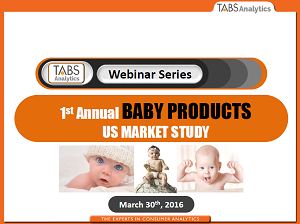Online Accounts for 20 Percent of Baby Products Sales: TABS 4/6/2016
Online sales account for 20 percent of all sales in the $30 billion baby products market, according to Shelton, Conn.-based TABS Analytics’ 2016 Baby Products U.S. Market Study. The online share of baby products sales is 10 times higher than the online share consumables sales for consumer packaged goods as measured by TABS in its Third Annual Consumer Value Study of Consumables. Amazon, Walmart.com and Target.com lead all online retailers representing 75 percent of online baby product sales.
“Online sales of baby products are out-competing all other segments of consumer packaged goods that we have surveyed over the last three years,” said TABS Analytics CEO Dr. Kurt Jetta. “In our consumables survey, we found that contrary to popular belief, online consumer packaged goods (CPG) sales are only at two percent, therefore, it is very noteworthy to find baby products far eclipsing all other consumable products. Brick-and-mortar retailers with ecommerce aspirations should treat baby product sales as the frontline of their battle for online success.”
The baby products study was conducted in March 2016 by Toluna, and 2,000 geographically and demographically dispersed adult consumers between the ages of 18 and 75 responded. The purpose of the study was to determine who, besides young families, is shopping in the category, and what the specific category purchase dynamics are. In addition, the study analyzed the outlet shopping patterns of the buyers, with a focus on comparing online to brick-and-mortar, and measuring non-tracked channels such as Babies”R”Us. Twenty-eight types of products across five major categories were included in the survey.
The five major infant and baby needs product segments surveyed were:
- Baby seat and safety products (i.e. car seats, strollers, baby monitoring devices)
- Baby feeding needs (i.e. cups, bottles, plates)
- Diapers and accessories
- Baby formula, food and drinks
- Baby care (i.e. powders, ointments, lotions)
40 Percent of All Purchases made Outside Mass Market Leaders
Mass market outlets account for around 54-63 percent of all baby product purchases with Walmart (17 to 18 percent) and Target (12.4 to 14 percent) leading the pack. The online channel’s 18 to 24 percent of share comprised Amazon (5.6 to 7.7 percent), Walmart.com (3.7 to 5.8 percent), Target.com (3.3 to 4.3 percent), Diapers.com (1.7 to 2.9 percent) and other ecommerce outlets (2.2 to 2.8 percent). Specialty outlets make up the other approximately 18.8 to 22.7 percent with Babies”R”Us and Toys”R”Us (9.5 to 11.2 percent) and other specialty stores (9.4 to 11.5 percent).
Presence of Children and Household Income Greatest Predictor of Heavy Buying
Overall, households headed by adults between the ages of 18-75 with children up to five years old are the heaviest buyers, accounting for 60 to 70 percent of purchases depending on the segment. Households with young children purchase 8.5 baby product types per year, compared to 1.6 for all other buyers.
Interestingly, 40 percent of baby products are purchased by consumers who don’t have any young children in their households, which represents 71 percent of all households. Thirty-seven percent of adults 18 to 75 shop this category.
For almost every type of baby product surveyed, there is a strong skew to upper income shoppers. Fifty-five to 65 percent of all baby care purchases were made by adults who made $75,000 or more per year in income. The baby care segment (shampoo, lotion, soap, powder and ointments) shows the flattest income distribution of the five segments surveyed. Whereas, the baby food and formula segments have the largest difference between high and low incomes.
Click here to download the slides from TABS recent webcast.
Click here for the video of the webcast
About TABS Analytics
Operating since 1998, TABS Analytics, formerly TABS Group, based in Shelton, Conn., is a technology-enabled analytics firm that aims to simplify and improve the way analytics are conducted in the consumer products industry. Primary services are TABS CatMan Advantage, an outsourced category management solution; TABS WorldView, a global business intelligence tool; and TABS Promo Insight™, a cloud-based software and consulting service that helps companies measure, plan and optimize trade spending.

